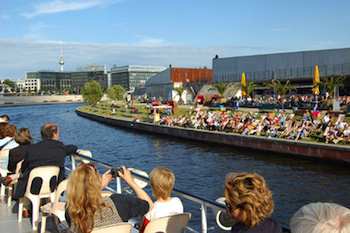- MENU
- HOME
- SEARCH
- WORLD
- MAIN
- AFRICA
- ASIA
- BALKANS
- EUROPE
- LATIN AMERICA
- MIDDLE EAST
- United Kingdom
- United States
- Argentina
- Australia
- Austria
- Benelux
- Brazil
- Canada
- China
- France
- Germany
- Greece
- Hungary
- India
- Indonesia
- Ireland
- Israel
- Italy
- Japan
- Korea
- Mexico
- New Zealand
- Pakistan
- Philippines
- Poland
- Russia
- South Africa
- Spain
- Taiwan
- Turkey
- USA
- BUSINESS
- WEALTH
- STOCKS
- TECH
- HEALTH
- LIFESTYLE
- ENTERTAINMENT
- SPORTS
- RSS
- iHaveNet.com: Travel
By Rick Steves

Spree River, Berlin
It's been 20 years since the Berlin Wall came down in Germany, and unification seems like old news. From a traveler's point of view, the business at hand seems to be to keep the economy going and visitors entertained. Things are changing in Switzerland as well. Germany's southern neighbor continues to impress me with the creative, constructive, and democratic ways it grapples with various challenges. Here are a few changes you'll encounter in both countries in 2010.
Big things are afoot in ever-changing Berlin. The formerly ugly and foreboding banks of the Spree River are now a delightful people-friendly park, with walks, thriving cafes, fake summer beaches, and glorious architecture. The changes make the once worthless Spree River sightseeing cruises a fine value and one of the best ways to enjoy a restful hour here.
A new super-short U-Bahn line runs between Pariser Platz/Brandenburg Gate and the Hauptbahnhof, with just one stop (at the Reichstag) en route. The stop at Pariser Platz is now called Brandenburger Tor. Previously known as Unter den Linden, it was one of East Berlin's famous unused "ghost" stations. Still, it remains a fascinating time-warp with circa 1950s decor intact.
After being completely rebuilt, the
Those touring Bavaria should check out the
Oberammergau's once-a-decade Passion play, an extravaganza starring 2,000 town citizens, will run from May 15 to Oct. 3. (There will be no tours of the theater complex this year.) For the first time, the play will take place in the afternoon and evening, rather than starting in the morning. Unless you're attending the play, it's best to stay away during this busy time.
Several of Germany's museums and churches are undergoing restoration. Wurzburg's glorious Imperial Hall at the Residenz, with its Tiepolo frescoes, is open following a two-year hiatus, though the adjacent and sumptuous Hofkirche Chapel -- the architectural highlight of the city -- will be closed through 2012. At Dresden's Royal Palace, the grand state rooms of Augustus the Strong will remain closed for several years, while the
Big things are also happening in Switzerland, where smoking is being phased out of eateries. Laws vary by city and canton (region), not by type of restaurant. So a fine restaurant in uber-traditional Appenzell is more likely to allow smoking than a bar in modern Zurich.
Bern's famous bear pits have closed, and a more politically correct bear park has opened. Since 1857, Bern had been keeping its bears in big, barren, concrete pits. But thanks to the terrorist activity of the B.L.M. --
Elsewhere in Switzerland, Zurich's
Whether clambering the Swiss Alps or exploring the Bavarian countryside, one thing is clear: Both countries are proud of their cultures and are working hard to show visitors why.
© Rick Steves Distributed by Tribune Media Services, Inc.
AUTOS | HOBBIES | EDUCATION | FAMILY | FASHION | FOOD & RECIPES | HOME DECOR | RELATIONSHIPS | PARENTING | PETS | TRAVEL | WOMEN
Vacation Travel - What's New in Germany and Switzerland for 2010